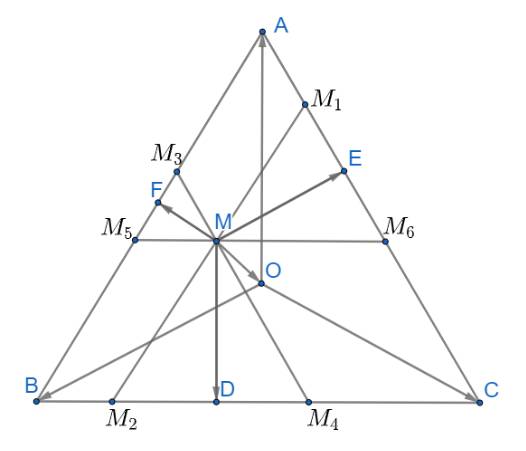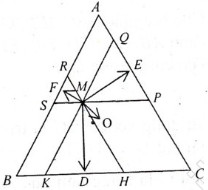Hãy nhập câu hỏi của bạn vào đây, nếu là tài khoản VIP, bạn sẽ được ưu tiên trả lời.

vecto x=vecto AB+vecto AC-vecto BC
=vecto AB+vecto AC+vecto CB
=vecto AB+vecto AB
=2*vecto AB
=>|vecto x|=2*3a=6a

Gọi A là trọng tâm tam giác ABC. AB = GB-GA = ỊmB-|kA 3 3 = |(AK-BM) = |(Ó-Ĩ) Ta có BC = GC - GB = (-GA - GB) - GB =-GA-2GB = AG + 2BG Chú ý: A là trọng tâm AABC thì GA + AB + AC = õ.

\(\overrightarrow {MD} + \overrightarrow {ME} + \overrightarrow {MF} = \left( {\overrightarrow {MO} + \overrightarrow {OD} } \right) + \left( {\overrightarrow {MO} + \overrightarrow {OE} } \right) + \left( {\overrightarrow {MO} + \overrightarrow {OF} } \right)\)
Qua M kẻ các đường thẳng \({M_1}{M_2}//AB;{M_3}{M_4}//AC;{M_5}{M_6}//BC\)
Từ đó ta có: \(\widehat {M{M_1}{M_6}} = \widehat {M{M_6}{M_1}} = \widehat {M{M_4}{M_2}} = \widehat {M{M_2}{M_4}} = \widehat {M{M_3}{M_5}} = \widehat {M{M_5}{M_3}} = 60^\circ \)
Suy ra các tam giác \(\Delta M{M_3}{M_5},\Delta M{M_1}{M_6},\Delta M{M_2}{M_4}\) đều
Áp dụng tính chất trung tuyến \(\overrightarrow {AM} = \frac{1}{2}\left( {\overrightarrow {AB} + \overrightarrow {AC} } \right)\)(với M là trung điểm của BC) ta có:
\(\overrightarrow {ME} = \frac{1}{2}\left( {\overrightarrow {M{M_1}} + \overrightarrow {M{M_6}} } \right);\overrightarrow {MD} = \frac{1}{2}\left( {\overrightarrow {M{M_2}} + \overrightarrow {M{M_4}} } \right);\overrightarrow {MF} = \frac{1}{2}\left( {\overrightarrow {M{M_3}} + \overrightarrow {M{M_5}} } \right)\)
\( \Rightarrow \overrightarrow {MD} + \overrightarrow {ME} + \overrightarrow {MF} = \frac{1}{2}\left( {\overrightarrow {M{M_2}} + \overrightarrow {M{M_4}} } \right) + \frac{1}{2}\left( {\overrightarrow {M{M_1}} + \overrightarrow {M{M_6}} } \right) + \frac{1}{2}\left( {\overrightarrow {M{M_3}} + \overrightarrow {M{M_5}} } \right)\)
Ta có: các tứ giác \(A{M_3}M{M_1};C{M_4}M{M_6};B{M_2}M{M_5}\) là hình bình hành
Áp dụng quy tắc hình bình hành ta có
\(\overrightarrow {MD} + \overrightarrow {ME} + \overrightarrow {MF} = \frac{1}{2}\left( {\overrightarrow {M{M_2}} + \overrightarrow {M{M_4}} } \right) + \frac{1}{2}\left( {\overrightarrow {M{M_1}} + \overrightarrow {M{M_6}} } \right) + \frac{1}{2}\left( {\overrightarrow {M{M_3}} + \overrightarrow {M{M_5}} } \right)\)
\( = \frac{1}{2}\left( {\overrightarrow {M{M_1}} + \overrightarrow {M{M_3}} } \right) + \frac{1}{2}\left( {\overrightarrow {M{M_2}} + \overrightarrow {M{M_5}} } \right) + \frac{1}{2}\left( {\overrightarrow {M{M_4}} + \overrightarrow {M{M_6}} } \right)\)
\( = \frac{1}{2}\overrightarrow {MA} + \frac{1}{2}\overrightarrow {MB} + \frac{1}{2}\overrightarrow {MC} = \frac{1}{2}\left( {\overrightarrow {MA} + \overrightarrow {MB} + \overrightarrow {MC} } \right)\)
\( = \frac{1}{2}\left( {\left( {\overrightarrow {MO} + \overrightarrow {OA} } \right) + \left( {\overrightarrow {MO} + \overrightarrow {OB} } \right) + \left( {\overrightarrow {MO} + \overrightarrow {OC} } \right)} \right)\)
\( = \frac{1}{2}\left( {3\overrightarrow {MO} + \left( {\overrightarrow {MA} + \overrightarrow {MB} + \overrightarrow {MC} } \right)} \right) = \frac{3}{2}\overrightarrow {MO} \) (đpcm)
Vậy \(\overrightarrow {MD} + \overrightarrow {ME} + \overrightarrow {MF} = \frac{3}{2}\overrightarrow {MO} \)


1.
\(\overrightarrow{AB}.\overrightarrow{BC}=\overrightarrow{AB}.\left(\overrightarrow{BA}+\overrightarrow{AC}\right)=\overrightarrow{AB}.\left(-\overrightarrow{AB}\right)+\overrightarrow{AB}.\overrightarrow{AC}=-AB^2=-25\)
2.
\(\overrightarrow{AB}.\overrightarrow{BD}=\overrightarrow{AB}\left(\overrightarrow{BA}+\overrightarrow{AD}\right)=-\overrightarrow{AB}.\overrightarrow{AB}+\overrightarrow{AB}.\overrightarrow{AD}=-AB^2+0=-64\)

Ta có: \(AH \bot CB \Rightarrow (\overrightarrow {AH} ,\overrightarrow {CB} ) = {90^o} \Leftrightarrow \cos (\overrightarrow {AH} ,\overrightarrow {CB} ) = 0 \Leftrightarrow \overrightarrow {AH} .\overrightarrow {CB} = 0\)
a) \(\overrightarrow {AB} .\overrightarrow {AH} - \overrightarrow {AC} .\overrightarrow {AH} = (\overrightarrow {AB} - \overrightarrow {AC} ).\overrightarrow {AH} = \overrightarrow {CB} .\overrightarrow {AH} = 0\)
\( \Leftrightarrow \overrightarrow {AB} .\overrightarrow {AH} = \overrightarrow {AC} .\overrightarrow {AH} \)
b) \(\overrightarrow {AB} .\overrightarrow {BC} - \overrightarrow {HB} .\overrightarrow {BC} = (\overrightarrow {AB} - \overrightarrow {HB} ).\overrightarrow {BC} = (\overrightarrow {AB} + \overrightarrow {BH} ).\overrightarrow {BC} = \overrightarrow {AH} .\overrightarrow {BC} = 0\)
\( \Leftrightarrow \overrightarrow {AB} .\overrightarrow {BC} = \overrightarrow {HB} .\overrightarrow {BC} \)


Qua M kẻ các đường thẳng song song với các cạnh của tam giác
A1B1 // AB; A2C2 // AC; B2C1 // BC.
Dễ thấy các tam giác MB1C2; MA1C1;MA2B2 đều là các tam giác đều. Ta lại có MD  B1C2 nên MD cũng là trung điểm thuộc cạnh B1C2 của tam giác MB1C2
B1C2 nên MD cũng là trung điểm thuộc cạnh B1C2 của tam giác MB1C2
Ta có 2 =
=  +
+ 
Tương tự: 2 =
=  +
+ 
2 =
=  +
+
=> 2(  +
+ +
+ ) = (
) = ( +
+ ) + (
) + ( +
+  ) + (
) + ( +
+ )
)
Tứ giác là hình bình hành nên
 +
+  =
= 
Tương tự:  +
+ =
= 
 +
+ =
= 
=> 2(  +
+ +
+ ) =
) =  +
+ +
+
vì O là trọng tâm bất kì của tam giác và M là một điểm bất kì nên
 +
+ +
+ = 3
= 3 .
.
Cuối cùng ta có:
2(  +
+ +
+ ) = 3
) = 3 ;
;
=>  +
+ +
+ =
= 

Đặt \(AB=a\Rightarrow AC=2a\)
\(\Rightarrow BC=\sqrt{AB^2+AC^2}=a\sqrt{5}\)
Áp dụng hệ thức lượng:
\(AB^2=BH.BC\Rightarrow BH=\dfrac{AB^2}{BC}=\dfrac{a^2}{a\sqrt{5}}=\dfrac{a\sqrt{5}}{5}=\dfrac{1}{5}.a\sqrt{5}\)
\(\Rightarrow BH=\dfrac{1}{5}BC\Rightarrow\overrightarrow{BH}=\dfrac{1}{5}\overrightarrow{BC}\)
\(\Rightarrow\overrightarrow{AH}=\overrightarrow{AB}+\overrightarrow{BH}=\overrightarrow{AB}+\dfrac{1}{5}\overrightarrow{BC}=\overrightarrow{AB}+\dfrac{1}{5}\left(\overrightarrow{BA}+\overrightarrow{AC}\right)=\overrightarrow{AB}-\dfrac{1}{5}\overrightarrow{AB}+\dfrac{1}{5}\overrightarrow{AC}\)
\(=\dfrac{4}{5}\overrightarrow{AB}+\dfrac{1}{5}\overrightarrow{AC}\)
\(\Rightarrow\left\{{}\begin{matrix}m=\dfrac{4}{5}\\k=\dfrac{1}{5}\end{matrix}\right.\) \(\Rightarrow S=\dfrac{10.4}{5}+\dfrac{2020.1}{5}=412\)